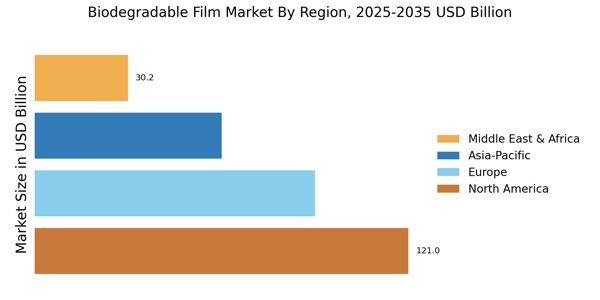Supportive Regulatory Frameworks
Regulatory support for eco-friendly solutions is emerging as a crucial driver for the Biodegradable Film Market. Governments across various regions are implementing stringent regulations aimed at reducing plastic waste and promoting sustainable practices. For example, several countries have introduced bans on single-use plastics, thereby creating a favorable environment for biodegradable alternatives. This regulatory push is expected to propel the demand for biodegradable films, as businesses seek to comply with new laws and meet consumer expectations for sustainability. Consequently, the market may witness accelerated growth as companies pivot towards biodegradable solutions to align with regulatory requirements.
Increasing Environmental Awareness
The growing consciousness regarding environmental issues appears to be a pivotal driver for the Biodegradable Film Market. Consumers are increasingly aware of the detrimental effects of plastic waste on ecosystems and human health. This awareness has led to a surge in demand for sustainable alternatives, including biodegradable films. According to recent data, the biodegradable film segment is projected to witness a compound annual growth rate of approximately 12% over the next five years. This trend suggests that as consumers prioritize eco-friendly products, manufacturers are likely to respond by expanding their offerings in the biodegradable film sector, thereby enhancing market growth.
Innovations in Biodegradable Materials
Technological advancements in material science are significantly influencing the Biodegradable Film Market. Innovations such as the development of new biopolymers and composites are enhancing the performance and applicability of biodegradable films. For instance, the introduction of polylactic acid (PLA) and polyhydroxyalkanoates (PHA) has expanded the range of biodegradable films available for various applications, including packaging and agriculture. These innovations not only improve the functionality of biodegradable films but also contribute to their cost-effectiveness. As a result, the market is likely to experience increased adoption rates, driven by the enhanced properties of these materials.
Rising Demand from the Packaging Sector
The packaging industry is increasingly adopting biodegradable films, which serves as a significant driver for the Biodegradable Film Market. With the rise in e-commerce and food delivery services, there is a growing need for sustainable packaging solutions. Biodegradable films offer an attractive alternative to traditional plastic packaging, as they can decompose naturally and reduce environmental impact. Market data indicates that the packaging segment accounts for over 60% of the total demand for biodegradable films. This trend suggests that as more companies in the packaging sector commit to sustainability, the demand for biodegradable films is likely to continue its upward trajectory.
Consumer Preference for Healthier Options
The shift in consumer preferences towards healthier and more sustainable options is influencing the Biodegradable Film Market. As consumers become more health-conscious, they are increasingly seeking products that align with their values, including those that minimize environmental impact. Biodegradable films, often perceived as safer and more eco-friendly, are gaining traction among consumers. This shift is particularly evident in the food industry, where biodegradable films are used for packaging organic and natural products. The increasing consumer preference for healthier options is expected to drive the growth of the biodegradable film market, as manufacturers respond to this demand by offering innovative and sustainable packaging solutions.


















Leave a Comment